2023.04.03
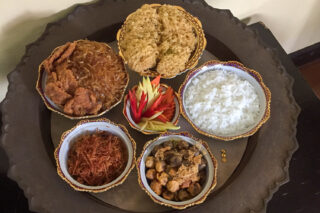
Thai society as seen through Thai royal cuisine‘Khao Chae’:Ethnic diversity from a Japanese perspective
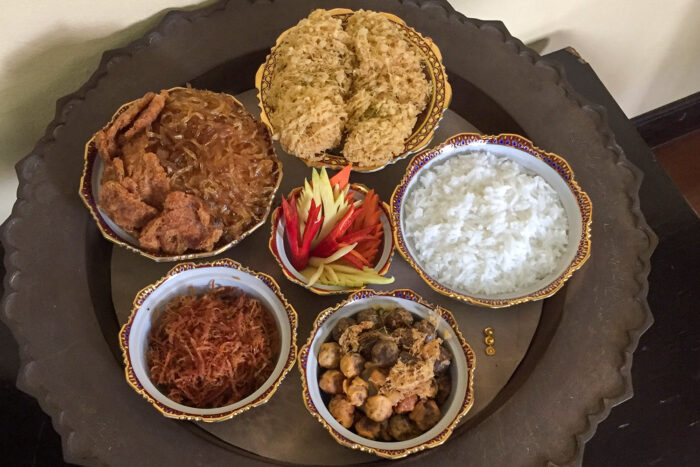
Thai cuisine is not the cuisine of the Thai people
There is no doubt that the Japanese have had relatively little interaction with other ethnic groups due to their geographical and historical background, as expressed in keywords such as‘Shima-guni’ (insularity) and‘Sakoku’ (national isolation). As a result, many Japanese people unconsciously assume that‘Japanese nationality’ and‘ethnic Japanese’ are almost synonymous and rarely think about their own ethnicity. Even a Japanese politician carelessly stated that‘Japan is a mono-ethnic society’, which was criticized widely.
I have been living in Thailand for nearly 20 years, and I sometimes feel that I am unknowingly trapped in the Japanese way of thinking. Recently, I have just realized that I had unconsciously interpreted the words‘Thai people’ and ‘Thai food’ as ‘people’ and ‘food’ of the ethnic Thai, which is one of the widespread ethnic groups of Southeast Asia. My misunderstanding was that Thailand is a country of ethnic Thais.
However, closer examination has revealed that even though it is called Thai food, it originally originated in countries other than Thailand and was brought to the country by various ethnic groups.
In this article, I would like to introduce the history and origins of Thai royal cuisine ‘Khao Chae’ as an example of such ethnic diversity in Thai society.
What is Thai royal cuisine ‘Khao Chae’?
In Thailand, there is a famous Thai royal cuisine called ‘Khao Chae’. It is a dish which cold water is poured over rice and eaten with several side dishes.
Although Thailand enjoys everlasting summer with a tropical climate, there are actually three seasons in a year: the‘rainy season’ (from May to October), when there is a lot of rainfall; the‘dry season’ (from November to February), when it is cool and little rain; and the‘hot season’ (from March to April), when it is extremely hot with temperatures close to 40 degrees.
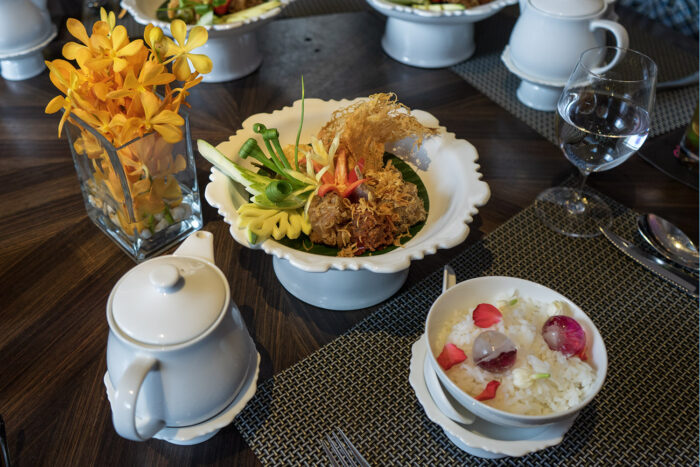
‘Khao Chae’, which means rice soaked in water in the Thai language, is a popular menu during the hot season from March to April. Thai people enjoy eating Khao Chae as a dish to ward off the heat. Khao Chae has a cool appearance with ice in water and is a perfect thirst-quenching dish when you have lost your appetite during the heat wave.
The Khao Chae was first served at the Thai court during the reign of King Rama IV of Thailand (reigned from 1851 to 1868). It subsequently became a popular menu among Thai royalty and aristocracy. It was probably one of the reasons why it was a royal cuisine, as the ice was rare in the past and was available only to the upper classes people.
Today, it is available commonly in Thai restaurants as a limited menu during the hot season in March and April.
The iced water over the rice is infused with the distinctive fragrance of herb-infused candles, and rose and jasmine petals are floated on top. Side dishes are served with carved vegetables and beautifully presented on a footed round tray.
Side dishes served with Khao Chae
‘Khao’ means rice and ‘Chae’ means soaked in Thai. Literally, it is rice soaked in cold water.
The Khao Chae is usually served in a set with a slightly different side dish. The Khao Chae side dishes often found in Thai restaurants include the following dishes.
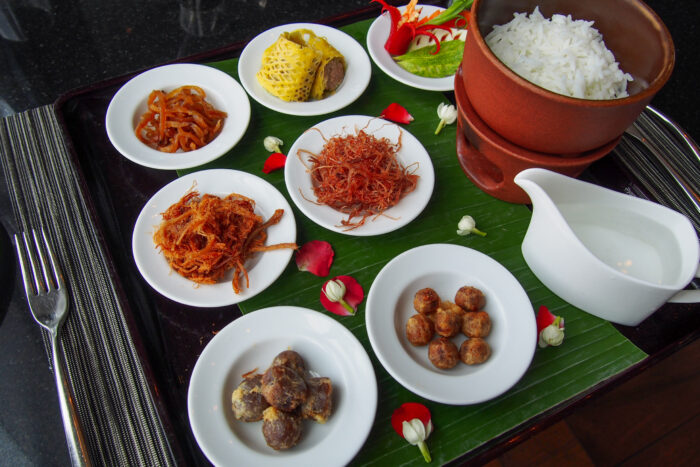
Deep Fried Kapi Balls (Luk Kapi Tot): Fermented shrimp paste called ‘kapi’ is mixed with coconut sugar, grilled fish, ginger, and lemongrass, mashed into a paste, rolled into small pieces and deep-fried with beaten egg.
Stuffed Shallots (Hua Home Tot): Remove the core of the small shallot, stuffed with a mixture of grilled fish flakes and herbs, battered and deep-fried.
Stuffed Sweet Peppers (Prick Yuak Sot Sai): The sweet peppers are stuffed with seasoned minced pork, steamed, and decorated with beaten eggs in a mesh pattern.
Sweetened fish or meat (Plaa Cham or Nua Cham): a dish made by frying dried fish or dried meat and coating it with sugar.
The variety of side dishes and recipes served with Khao Chae varies from restaurant to restaurant and chef to chef, which is one of the pleasures of eating Khao Chae.
Khao Chae was originally a Mon dish
Khao Chae was originally a dish of the Mon people, who have lived in Southeast Asia for a long time. The Mon had a tradition of offering Khao Chae to the gods at the Songkran Festival in April, the height of the hot season, in the hope that their offspring would prosper and bear children. The Mon people’s original ‘Khao Chae’ is simple in presentation and the accompanying side dishes are slightly different from those seen in Thailand today.
It was a Mon woman named Sonklin, who was a consort of King Rama IV of Thailand, who first offered such Mon food to him. King Rama IV built Phra Nakhon Khiri Royal Palace, a remote palace on top of a mountain in Phetchaburi Province, commonly known as Khao Wang, which he visited to stay during the hot season. Sonklin, who accompanied him, offered Khao Chae to King Rama IV to get rid of the heat, which led to its spread within the royal court.
Even today, in Phetchaburi Province, the Khao Chae is still sold at the local markets, retaining a trace of those days, and has become a Phetchaburi specialty.

Later, Khao Chae was favored by successive Thai kings, and the royal ladies and court ladies living in the court competed with each other to create their own elaborations, which developed into the elegant Thai royal cuisine, Khao Chae.
Where did the Mon people come from?
By the way, why did King Rama IV have a Mon female consort at that time?
Polygamy was the norm for Thai kings in ancient times, and women from various regional royal families and aristocratic families lived at the court, partly as a political marriage.
Sonklin, a consort of King Rama IV, was a descendant of the Mon royal family, who migrated to Thailand (the name of the country at that time was ‘Siam’, however, hereafter I will call it the present name ‘Thailand’) during the reign of King Taksin of the Thonburi dynasty (reigned from 1767 to 1782).
The Mon were the people who once founded the ancient kingdoms of Dvaravati (in present-day central Thailand) and Haripunchai (in present-day northern Thailand) and were among the first in Southeast Asia to accept Theravada Buddhism. Since the 13th century, they built their kingdom at Pegu in Lower Burma, but were often defeated in battles with the Burmese and forced to flee their country, and from the 16th to 19th centuries, many Mon intermittently fled to Thailand as refugees.
Mon refugees consisted of many social classes, including royalty, Buddhist monks, soldiers, and ordinary citizens, and were assigned a place of residence and role in Thailand according to their status. Even though the Mon is a different ethnic group, they were culturally compatible with the Thai people, who shared the same Theravada Buddhist, and the Mon people integrated into Thai society and became Mon Thais. They went to war with the Thai army against the Burmese, and the Mon people who were successful rose through the ranks to become high-ranking government officials, and some families even became members of the Thai nobility.
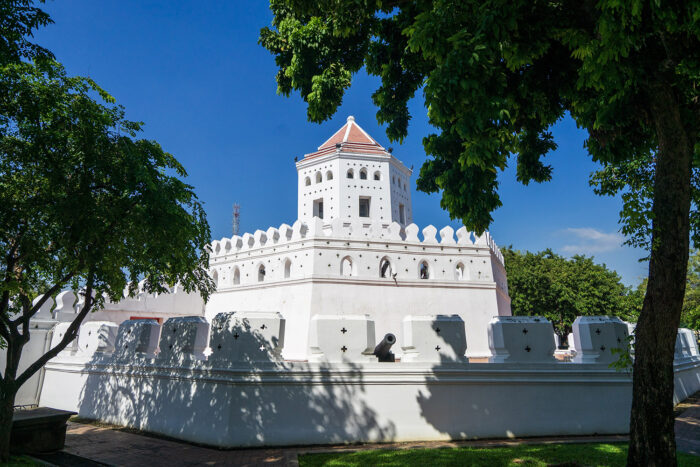
Phraya Cheng, Mon royal family member in Thailand
Sonklin’s great-grandfather, Phraya Cheng, was a nephew of Binnya Dala, the last Mon king of the restored Hanthawaddy Kingdom (from 1740 to 1757). The Mon lost their country to Burmese attacks and Phraya Cheng was forced to serve in the Burmese army, but in 1774 he led a failed rebellion against the Burmese, bringing 3,000 Mon people to Thailand to seek the patronage of King Taksin of the Thonburi dynasty.
Following King Taksin, during the reign of King Rama I of the Bangkok dynasty, Phraya Cheng led the Mon army to join the Thai army and fought many battles against the Burmese. In recognition of his achievements, he was promoted to the official rank of ‘Chao Phraya Mahayotha’.
Phraya Cheng’s descendants became Mon Thai nobles with the Thai style surname of Kachaseni, and Sonklin, who was from this family, lived at the court as a consort of King Rama IV, and the Thai royal cuisine ‘Khao Chae’ was born.
Incidentally, the Mon people who migrated to Bangkok with Phraya Cheng settled in the vicinity of Pak Kret in Nonthaburi Province, which is adjacent to the northern part of Bangkok, and Phra Pra Daeng in Samut Prakan Province, the southeastern part of Bangkok, and there are still many Mon Thais living in these areas today.
Thailand has developed while accepting other ethnic groups
Southeast Asia has been home to many ethnic minorities since ancient times. New small kingdoms rose and fell as a result of inter-ethnic wars. Along with wars, there were constant ethnic migrations due to forced emigration, prisoners of war, and refugees.
Furthermore, being geographically located between the two great powers of China and India, merchants and seafarers of various ethnic groups from the East and West constantly visited Thailand through trade activities, and in many cases, they migrated in search of new land.
Thailand, which developed as a port-polity called Ayutthaya in ancient times, has also welcomed various ethnic groups from all over the world. More than 30 ethnic groups, including the Japanese, lived in Ayutthaya, and as long as they were competent, even foreigners were promoted to high positions in the government and became Thai aristocrats.
Today’s capital, Bangkok, continues the trend of the Ayutthaya era, with many ethnic groups living in a veritable melting pot. Chinese Thais are the most numerous in Bangkok, but there are also Thais of all ethnic origins, including Mon, Lao, Khmer, Malay, Portuguese, Indian, Persian, and so on.
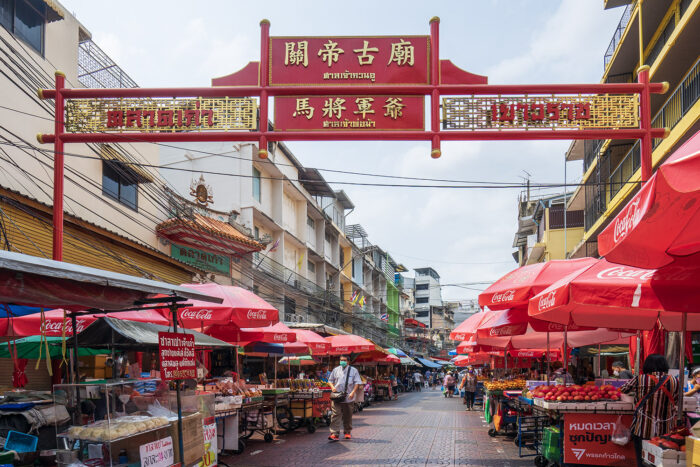
In addition, there is a high degree of inter-ethnic marriage in Thai society, so it is said that there is probably no pure Thai descent today.
In Thailand, in 1939, Prime Minister Phibunsongkhram issued Thai cultural mandates known as ‘Rattaniyom’, which is said it was a cultural revolution that emphasized that the Thai nation was a nation of ethnic Thais. It called on many ethnic groups living in the territory of Thailand to become ‘Thai’, including forcing them to be educated in the Thai language.
Today, all Thai citizens, no matter what their ethnic background, speak Thai, have Thai citizenship and identify themselves as ‘Thai’. Therefore, even if the culture or food is originally from another ethnic group, it is called ‘Thai culture’ or ‘Thai food’, and it is probably difficult to notice its ethnic diversity.
The author, who was born and raised in Japan, is often surprised by the dynamism and tolerance of cultural transformation in Thai society while living in Thailand, and at the same time finds a huge difference from the rather closed Japanese society with little ethnic diversity.
PROFILE

Mitsuko Horimoto
Living in Bangkok, Thailand since 2003. Completed the master program at the School of Language and Communication at the National Institute of Development Administration (NIDA) in Thailand and the doctoral program at the Graduate School of Intercultural Studies at Kobe University in Japan. Research fields are intercultural communication and Thai culture. Currently, while working for the Japanese Chamber of Commerce, Bangkok, also providing travel information about Thailand on the personal blog “Thailand Gaho (thailandgaho.com)”. Major publication: Anger Coping Strategies and Values of the Thais, The Journal of Thai Studies Vol.15.
